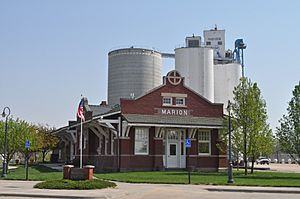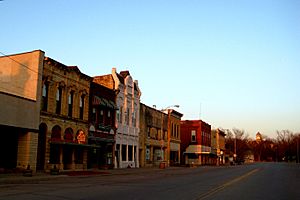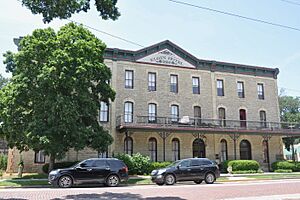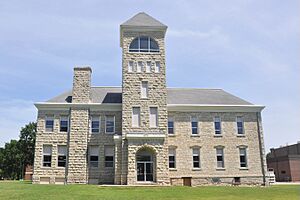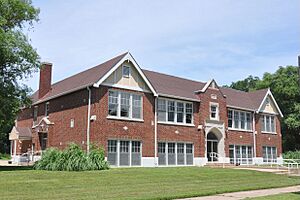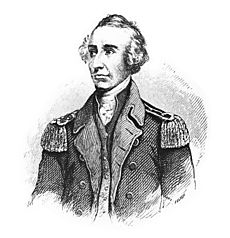Marion, Kansas facts for kids
Quick facts for kids
Marion, Kansas
|
|
|---|---|
|
City and County seat
|
|
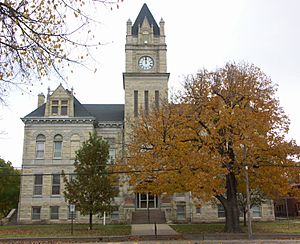
Marion County Courthouse (2009)
|
|
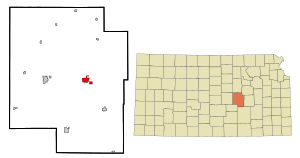
Location within Marion County and Kansas
|
|
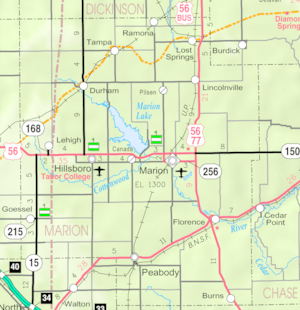
|
|
| Country | United States |
| State | Kansas |
| County | Marion |
| Township | Centre |
| Platted | 1866, 1871, 1873 |
| Incorporated | 1875 |
| Named for | Francis Marion |
| Government | |
| • Type | Mayor–Council |
| Area | |
| • Total | 2.70 sq mi (6.98 km2) |
| • Land | 2.69 sq mi (6.96 km2) |
| • Water | 0.01 sq mi (0.02 km2) |
| Elevation | 1,342 ft (409 m) |
| Population
(2020)
|
|
| • Total | 1,922 |
| • Density | 711.9/sq mi (275.36/km2) |
| Time zone | UTC-6 (CST) |
| • Summer (DST) | UTC-5 (CDT) |
| ZIP code |
66861
|
| Area code | 620 |
| FIPS code | 20-44750 |
| GNIS ID | 485619 |
Marion is a city in Marion County, Kansas, United States. It is also the county seat, which means it's where the main government offices for the county are located. In 2020, about 1,922 people lived here. The city was named after Francis Marion, a famous general from the American Revolutionary War known as the "Swamp Fox".
A Look Back: The History of Marion
Early Beginnings and Native Americans
For thousands of years, the Great Plains of North America were home to nomadic Native Americans. These groups moved around, following animals and seasons. Later, in the 16th to 18th centuries, France claimed much of this land.
In 1762, after a war, France secretly gave this land to Spain. But in 1802, Spain returned most of it to France.
How Kansas Became Part of the U.S.
In 1803, the United States bought a huge area of land, including what is now Kansas, from France. This was called the Louisiana Purchase. It was a massive deal, costing only about 2.83 cents per acre!
In 1806, an explorer named Zebulon Pike led an expedition west from St. Louis. Part of their journey followed the Cottonwood River right through what is now Marion County.
Kansas became a U.S. territory in 1854 and then the 34th U.S. state in 1861. Marion County was created in 1855.
Founding of Marion and the Railroads
The city of Marion Centre was founded in 1860 and became the county seat. It was renamed Marion in 1881. The city's name honors Francis Marion, a hero of the American Revolution.
Railroads played a big role in Marion's growth.
- In 1879, the Atchison, Topeka and Santa Fe Railway built a branch line connecting Marion to other towns. This line was very important for moving goods and people. The old Santa Fe train station in Marion is now the Marion Library!
- In 1887, another railroad, the Chicago, Kansas and Nebraska Railway (later known as the "Rock Island"), built a line through Marion.
- A special railroad, the Marion Belt and Chingawasa Springs Railroad, was built in 1889. It went to a health spa called Chingawasa Springs. People would travel there for relaxation. However, the spa closed in 1893, and the railroad stopped running.
Marion officially became a city in 1888.
20th Century Changes and Floods
In 1912, the National Old Trails Road, a major highway, was routed through Marion. This helped connect the city to other parts of the country.
Marion has faced challenges with floods.
- In 1937, the Civilian Conservation Corps built the Marion County Lake for recreation.
- In 1951, heavy rains caused major floods across Kansas, including Marion.
- To prevent future floods, the Marion Reservoir was built northwest of Marion between 1964 and 1968. Levees (protective walls) were also built in low areas of Marion.
Marion in the 21st Century
In 2010, the Keystone-Cushing Pipeline was built west of Marion. This pipeline carries oil and caused some debate about its impact on roads and the environment.
Exploring Marion: Geography and Climate
Marion is located in an area called the Flint Hills. The city covers about 2.99 square miles (7.75 square kilometers). Most of this is land, with a small amount of water.
Weather in Marion
Marion has a climate with hot, humid summers. Winters are generally mild to cool. This type of weather is known as a humid subtropical climate.
Who Lives in Marion: Population Details
| Historical population | |||
|---|---|---|---|
| Census | Pop. | %± | |
| 1880 | 857 | — | |
| 1890 | 2,047 | 138.9% | |
| 1900 | 1,824 | −10.9% | |
| 1910 | 1,841 | 0.9% | |
| 1920 | 1,928 | 4.7% | |
| 1930 | 1,959 | 1.6% | |
| 1940 | 2,086 | 6.5% | |
| 1950 | 2,050 | −1.7% | |
| 1960 | 2,169 | 5.8% | |
| 1970 | 2,052 | −5.4% | |
| 1980 | 1,951 | −4.9% | |
| 1990 | 1,906 | −2.3% | |
| 2000 | 2,110 | 10.7% | |
| 2010 | 1,927 | −8.7% | |
| 2020 | 1,922 | −0.3% | |
| U.S. Decennial Census | |||
Population in 2020
In 2020, the 2020 United States census counted 1,922 people living in Marion. There were 860 households and 502 families. Most residents (about 94%) were white. About 3.3% of the population identified as Hispanic or Latino.
About 23.8% of households had children under 18. The average age in Marion was 46.3 years. The median household income was about $46,548.
Population in 2010
The 2010 census showed 1,927 people living in Marion. The city had 846 households. About 97.6% of the population was White.
About 28.6% of households had children under 18. The average age was 44 years.
Fun Things to Do: Arts, Culture, and Attractions
Local Events to Enjoy
- Chingawassa Days Festival: A local festival with fun activities.
- Old Settler's Day: A day to celebrate the history of the area.
- Art in the Park and Craft Show: An event to see and buy local art and crafts.
Places to Visit in Marion
Marion has five places listed on the National Register of Historic Places (NRHP). These are important buildings recognized for their history.
- Elgin Hotel: A historic hotel, now a Bed and Breakfast.
- First Presbyterian Church: A beautiful old church building.
- Hill Grade School: A former school building.
- Marion County Courthouse: The main building for the county government.
- Marion County Museum: A museum where you can learn about the area's past. It used to be the First Baptist Church.
Outdoor Fun Near Marion
- Marion County Lake: A great spot for outdoor activities, located southeast of Marion.
- Marion Reservoir: A large lake northwest of Marion, perfect for fishing, boating, and enjoying nature.
Learning in Marion: Schools and Library
Public Schools in the Area
Students in Marion attend schools in the Marion–Florence USD 408 public school district.
- Marion High School (Kansas)
- Marion Middle School
- Marion Elementary School
The City Library
Each school in the USD 408 district has its own library. The city also has the Marion City Library. It's part of a system that lets you borrow books from other libraries in the area.
Staying Connected: Media and Transportation
Local News
- Marion County Record: The official newspaper for Marion and Marion County.
- Hillsboro Free Press: A free newspaper for the wider Marion County area.
Radio and TV
Marion receives radio and TV signals from the Wichita and Hutchinson areas. You can also get cable and satellite TV.
Getting Around Marion
- Highways: U.S. Route 56 runs north of the city, and U.S. Route 77 is just east. Kansas Highway 256 goes through the center of town as Main Street.
- Railroad: The Union Pacific Railroad has a line that runs north-south through Marion.
- Airport: The Marion Municipal Airport is located southeast of the city.
Famous Faces from Marion
Many notable people have connections to Marion:
- Randolph Carpenter (1894–1956): A U.S. Representative from Kansas and a World War I veteran.
- Charlie Faust (1880–1915): A professional baseball player.
- Beverly Hoch (born 1951): A talented opera singer (soprano).
- Edward Hoch (1849–1925): A former Governor of Kansas and newspaper editor.
- Homer Hoch (1879–1949): A U.S. Congressman and a judge on the Kansas Supreme Court.
- Tex Jones (1885–1938): Another professional baseball player.
- Eric Meyer (born 1953): A journalism professor and Pulitzer Prize nominee.
- Fay Moulton (1876–1945): An Olympic sprinter, football player and coach, and lawyer.
- Samuel Peters (1842–1910): A U.S. Representative and judge.
- William Runyan (1870–1957): A preacher and composer of the famous hymn "Great Is Thy Faithfulness".
- Carla Stovall (born 1957): A former Kansas Attorney General.
See also
 In Spanish: Marion (Kansas) para niños
In Spanish: Marion (Kansas) para niños


